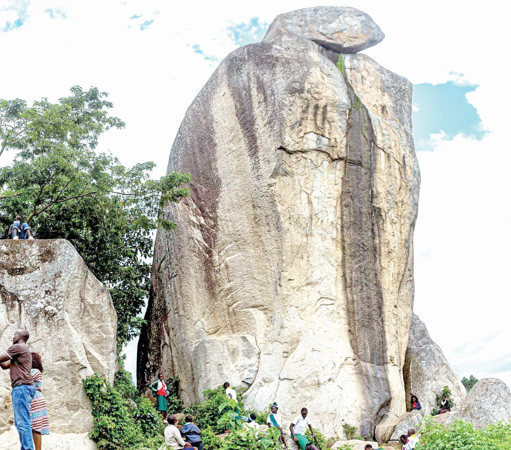Puzzle after tears dry from Kakamega weeping stone eyes

Just what caused the famous “crying stone” at Ilesi in Shinyalu constituency, Kakamega County to stop “shedding tears”?
This is the mystery that experts are trying to unravel as they seek to have the humongous rock, which remains a major tourist attraction, beginning to “cry” again.
Experts from the National Museums of Kenya (NMK) in conjunction with Kakamega county government and local elders are working round the clock to ascertain why water that used to stream from the rock stopped and if it is possible to have it back.
The water was the main source of attraction to the tourist site and there are fears that its absence may render the rock useless.
According to the Kakamega County Elders Council Chairman Eliud Mushila, the water might have stopped due to hazardous environmental practices around the site.
“We used to have indigenous trees and other bushes around the site which contributed to the water that gushed out of the rock earning it the name ‘crying stone’,” Mzee Mushila explained.
“But you can now see that individuals have encroached on the land and planted eucalyptus trees that consume water that could get into the rock then gush out,” he added.
NMK official Evans Taracha asked the county government to reclaim the site and cut down all the eucalyptus trees planted around it.
“We are deeply concerned about the goings-on around the crying stone and I urge the Kakamega County Government to move fast and reclaim the site. This is in addition to such other sites across the county,” said Taracha who is heading the Natural Products Industry Initiative under NMK in mapping out cultural sites and activities across the 13 counties.
Head of Public Service in the county Government Lawrence Omuhaka said the crying stone had been gazetted as a heritage site but expressed concern that some individuals were destroying it.
“Accessing the site has even become a major headache because some individuals laid claim on it and are engaged in activities that are hazardous. We will use all means to reclaim the site and develop it to boost tourism in our County,” he added.
The team also wants bullfighting to be gazetted as a sport so that the cultural activity can be officially recognized.
The NMK under its Natural Products Industry Initiative have mapped out bullfighting and other cultural activities and heritage sites in the County in a bid to push for their patenting and effectively boost tourism and revenue flows.
Taracha officially handed the Indigenous Knowledge Management System that they had profiled and created to the county government on Thursday.
“Bullfighting is an interesting activity that has not been fully exploited for years yet it is a dependable generator of income for the owners and their fans. Time has come for it to be officially recognized and supported,” he added.
Taracha pointed out that shrinking of public spaces was a threat to the age-old sport that is popular in Kakamega.
“We only have one bullfighting arena at Malinya in Ikolomani Constituency and I feel this not enough. The national and county governments should start taking bullfighting seriously,” he added.
He said Kakamega had unique tourist attractions and cultural sites that had not been exploited to the advantage of the County and its people.
“Besides the crying stone and bullfighting, we have other unique tourist attractions such as the Kakamega Forest, Misango and Ebutiati Hills, isukuti, shilili and litungu music, traditional delicacies and a Nabongo (King) which is why the county was one of the 13 that we picked to profile their cultural activities and heritage sites,” Taracha said.
“What has been documented is going to be fertile ground for content creation. We should preserve what we have to protect it from being stolen. Our main objective is to use culture to create wealth,” he added.
Omuhaka, who received the system from NMK, said they would push for increased allocation of resources to the Department of Culture so as to promote traditional activities and heritage sites that would boost tourism.
“Bullfighting is dear to many of our people but we are sorry as a county administration that we have not been serious enough to exploit it alongside other cultural activities and sites. It will no longer be business as usual,” he added.












